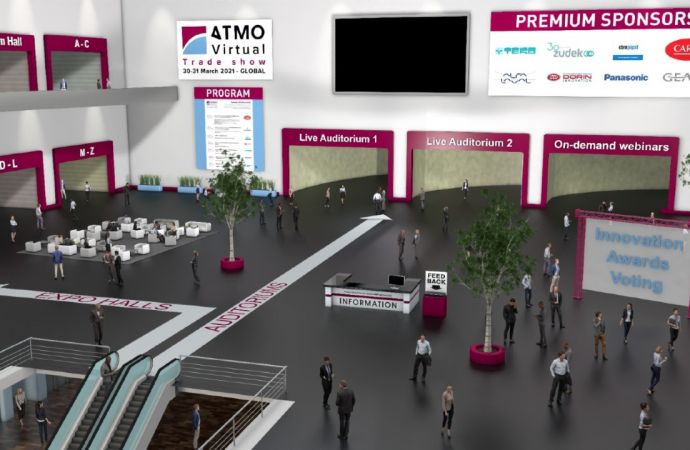The ‘2nd IIR Workshop on Refrigerant Charge Reduction in Refrigerating Systems’ was held last week at the Royal Institute of Technology (KTH), Stockholm, Sweden in conjunction with the conference on ‘Sustainable Refrigeration and Heat Pump Technology’. Several of the workshop presentations focused on methods on reducing charge in ammonia systems.

Design and Experimental Analysis of a Water Chiller Using Ammonia as Refrigerant, L. Cecchinato, University of Padova
With the main growth area expected for ammonia in future being the increased use of chillers for air conditioning of commercial buildings such as offices, hotels, hospitals, shopping centre, university and conference centres, the Department of Fisica Tecnica of the University of Padova together with company SCM FRIGO are undertaking a research project for the development of a low refrigerant charge ammonia water chiller. The goal of the project is to reduce the ammonia charge significantly so as to avoid the restriction of heavy regulations.
Cecchinato described the main features of the newly designed prototype, including:
The researchers note that the prototype was developed using components already available on the market, which means that the current technology is ready for supplying the market with ammonia refrigerating plants in large numbers. Availability of components together with good energy efficiency values and low refrigerant charge levels are key for the wide diffusion of ammonia chillers as a substitute for the traditional halocarbon systems. The researchers conclude that smaller low charge ammonia systems, chillers in particular, used for refrigeration or air conditioning as part of a secondary loop or cascade system provide excellent potential for market penetration of ammonia.
Low Charge Ammonia Evaporator with Separator Vessel, R. Christensen, Alfa Laval
Christensen discussed the possibilities to obtain low ammonia plant charges by minimising the charge in the evaporator and separator vessel, focusing on compact exchangers used for ammonia systems like semi-welded plate heat exchangers or the AlfaNova all stainless steel fusion bonded compact heat exchanger. The company has developed a dedicated separator vessel called U-turn for its semi-welded plate heat exchangers. The main drivers for the development has been to design a very compact flooded system with increased efficiency by enabling higher evaporation temperatures and at the same time reduce the refrigerant charge to a minimum as well as ensuring correct operating conditions by synchronizing pressure drops in the evaporator and liquid head. Unlike traditional separator vessels for evaporators that consist of a short vessel with a fairly large diameter, the U-turn separator has a smaller diameter and consequently needs a longer length to obtain the same separation efficiency. The vessel is made of standard size stainless steel pipes and bends and forms a “U” on top of the evaporator.
Christensen noted that the use of high pressure float valves for control together with plate condensers made it possible to minimise the refrigerant charge. Further refrigerant charge reductions could be achieved by reducing the inlet port size, the drop leg and oil pot size, although that could compromise efficiency and functionality. Indeed the inlet port acts also as an oil separating vessel and hence a smaller port could entail the risk of reducing performance by letting oil into the evaporator.
Limited Charge Shell-and-Tube Ammonia Spray Evaporator with Enhanced Tubes, Z. Ayub, Isotherm
The Texas based manufacturer of refrigeration equipment provided a system for a process cooling application at a chemical plant with an evaporator that would provide 2.2°C (36°F) water without the danger of freezing the tubes. A shell-and-tube spray evaporator was chosen to replace two halocarbon centrifugal chillers that were part of a cooling system providing chilled water for process application. The characteristics of spray evaporators rendered them attractive for such applications: For example the refrigerant charge is orders of magnitude lower than the same capacity flooded evaporator has certain, while thanks to the low charge and the fact that the shell is devoid of liquid refrigerant, the equipment is well guarded against freeze-up in the event of process pumps or refrigerant controls failure. In order to further improve the efficiency of the spray evaporator, the company incorporated special Doubly Enhanced carbon steel tubes. Being operational for several years, the unit has exceeded expectations under different seasonal conditions. Water outlet temperature as low as 0.6°C (33°F) and storage tank temperature as low as 1.7°C (35°F) have been recorded.
With the main growth area expected for ammonia in future being the increased use of chillers for air conditioning of commercial buildings such as offices, hotels, hospitals, shopping centre, university and conference centres, the Department of Fisica Tecnica of the University of Padova together with company SCM FRIGO are undertaking a research project for the development of a low refrigerant charge ammonia water chiller. The goal of the project is to reduce the ammonia charge significantly so as to avoid the restriction of heavy regulations.
Cecchinato described the main features of the newly designed prototype, including:
- refrigerating capacity of 120 kW
- open inverter-driven screw compressor with nominal volumetric flow rate equal to 118 m3/h and rotational speed of about 2900 rev/min
- evaporation and condensation temperatures of 2°C and 50°C respectively
- temperature of the secondary refrigerant (water) at the evaporator outlet was set at 7°C and at the evaporator inlet at 12°C
- plate heat exchanger evaporator with 52 plates having high chevron angle with overall dimensions equal to 618x191 mm
The researchers note that the prototype was developed using components already available on the market, which means that the current technology is ready for supplying the market with ammonia refrigerating plants in large numbers. Availability of components together with good energy efficiency values and low refrigerant charge levels are key for the wide diffusion of ammonia chillers as a substitute for the traditional halocarbon systems. The researchers conclude that smaller low charge ammonia systems, chillers in particular, used for refrigeration or air conditioning as part of a secondary loop or cascade system provide excellent potential for market penetration of ammonia.
Low Charge Ammonia Evaporator with Separator Vessel, R. Christensen, Alfa Laval
Christensen discussed the possibilities to obtain low ammonia plant charges by minimising the charge in the evaporator and separator vessel, focusing on compact exchangers used for ammonia systems like semi-welded plate heat exchangers or the AlfaNova all stainless steel fusion bonded compact heat exchanger. The company has developed a dedicated separator vessel called U-turn for its semi-welded plate heat exchangers. The main drivers for the development has been to design a very compact flooded system with increased efficiency by enabling higher evaporation temperatures and at the same time reduce the refrigerant charge to a minimum as well as ensuring correct operating conditions by synchronizing pressure drops in the evaporator and liquid head. Unlike traditional separator vessels for evaporators that consist of a short vessel with a fairly large diameter, the U-turn separator has a smaller diameter and consequently needs a longer length to obtain the same separation efficiency. The vessel is made of standard size stainless steel pipes and bends and forms a “U” on top of the evaporator.
Christensen noted that the use of high pressure float valves for control together with plate condensers made it possible to minimise the refrigerant charge. Further refrigerant charge reductions could be achieved by reducing the inlet port size, the drop leg and oil pot size, although that could compromise efficiency and functionality. Indeed the inlet port acts also as an oil separating vessel and hence a smaller port could entail the risk of reducing performance by letting oil into the evaporator.
Limited Charge Shell-and-Tube Ammonia Spray Evaporator with Enhanced Tubes, Z. Ayub, Isotherm
The Texas based manufacturer of refrigeration equipment provided a system for a process cooling application at a chemical plant with an evaporator that would provide 2.2°C (36°F) water without the danger of freezing the tubes. A shell-and-tube spray evaporator was chosen to replace two halocarbon centrifugal chillers that were part of a cooling system providing chilled water for process application. The characteristics of spray evaporators rendered them attractive for such applications: For example the refrigerant charge is orders of magnitude lower than the same capacity flooded evaporator has certain, while thanks to the low charge and the fact that the shell is devoid of liquid refrigerant, the equipment is well guarded against freeze-up in the event of process pumps or refrigerant controls failure. In order to further improve the efficiency of the spray evaporator, the company incorporated special Doubly Enhanced carbon steel tubes. Being operational for several years, the unit has exceeded expectations under different seasonal conditions. Water outlet temperature as low as 0.6°C (33°F) and storage tank temperature as low as 1.7°C (35°F) have been recorded.
MORE INFORMATION
Related stories

















